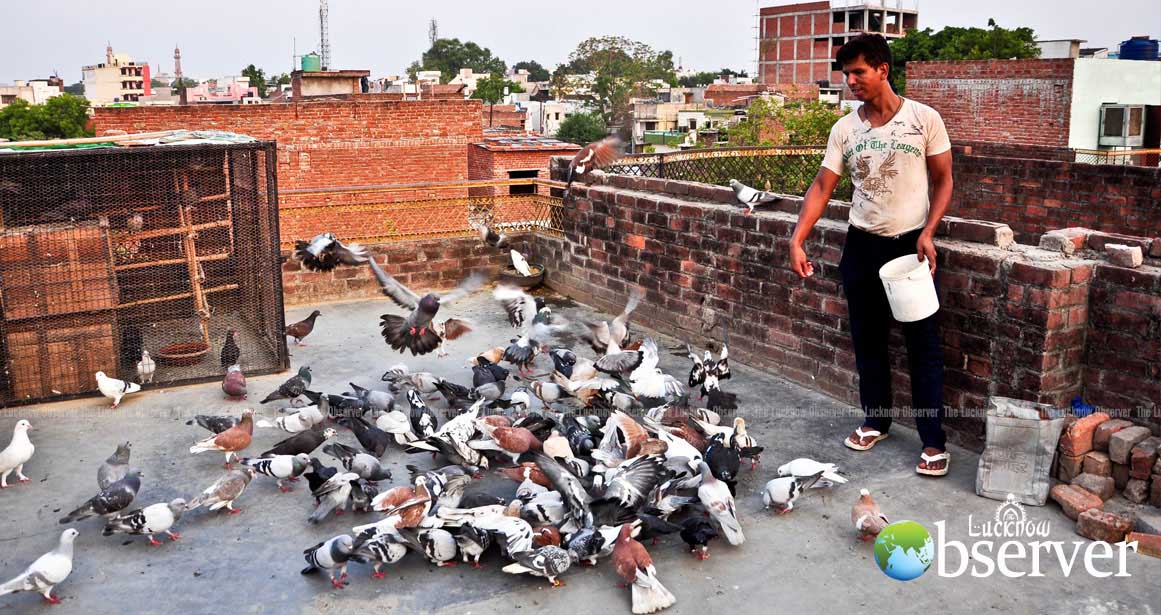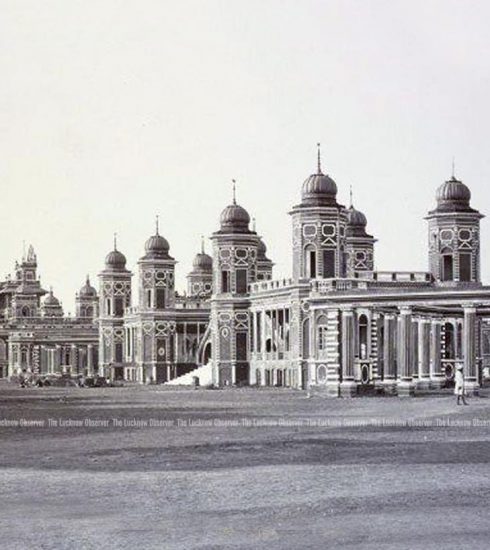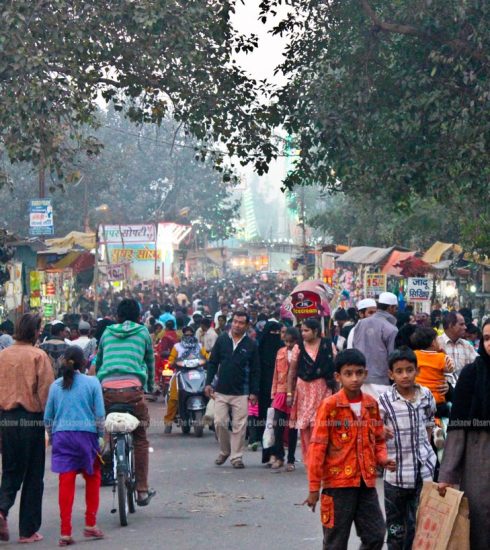Lucknow’s Culture In The Sky
The Ancient Custom of Training Pigeons
There has always been talk of setting the beloved free, but with a heavy heart for the possibility of them not returning ever. Still when one can’t think of letting go a bird without doubt, how is it that kabootar baazi, though almost endangered, still lives on? On the rooftops of old Lucknow, when long tired days would stretch into cool evenings, kabootar baazi would be a common sight. Calling it a ‘shauk’, people in those times loved to keep pigeons. To feed them, was their best leisure time and watching them y in circles would give them simple happiness or a music that they visually enjoyed. Some white as snow others spotted with chocolate brown, or light grey, ‘paaltu’ pigeons were the pride of their masters’ homes. There are a variety of pigeons for different purposes varying from ornamentalisation of homes to high flight or even betting. Pamoze and Laqqua are, to this day, adored for the softness of their feather and handsome looks; Pamoze for its feathers that cover its feet, making them look beautiful and Laqqua for its high head and out chested figure. But Girahbaaz and Nisoura are strong breeds of pigeons that were most suitable for betting, which has almost come to an end now except for only some places where the tradition of comparing the birds’ flight time with other groups still exists.
In Lucknow, while it is popularly known that this ‘shauk’ dates back to the time of Asif-ud-Daula, there are alternative sources claiming it to be much older than that. Patronized by the Nawabs of Awadh, the tradition was at its peak, as the Nawabs, out of the love of beauty, would buy different varieties of pigeons, which were available at high prices in the market. Only the very wealthy or those from the aristocratic class could own a pack of pigeons. Later it became more common and finally what was earlier considered an unattainable luxury, trickled down to lower levels in the society. More common people started buying pigeons and passed on the tradition of keeping pet pigeons to newer generations. Taking inspiration from the Nawabi class, people from slightly higher strata of middle class, internalized it. This was only met by depreciating prices in the markets. Even in late 20th century people used to own 50-100 pigeons at a time. They were kept in compartmentalized cages in open chabootaras. The pet pigeons would be freed from the cages to y around in groups around evening time. They would be out for long periods, sometimes flying high above the mohalla, sometimes right above the house of their owner. The height and the time period of the flight would depend on the breed of the pigeons. When the evening would grow darker and the master would almost want to leave it to that, the pigeons would return, merrily uttering their wings and their eyes shining in the twilight. Owners of pigeons have never had the complaint of them not returning on their own, as the pigeons naturally perceive their masters’ home as their own and have great sense of belongingness other than the intelligence of direction. They come to their cages for they know this was where they belonged. “Maybe because they were wise enough to understand that everything from their feeding to safety is well taken care of here, or because they were just used to this way of living”, says a shopkeeper in chowk whose father once owned around 50 pigeons.
It was not something that was rarely done, but a daily affair. Even today there are many places in the old city where Kabootar baazi is still in practice. In fact in Hussainabad area of Lucknow, some people claim that the tradition has somewhat increased over the period of time, while people in other areas of the old part of the city deny this. Still there are many people today, whose fathers and forefathers never had pet pigeons, that have now acquired the ‘shauk’, seeing some other people in the mohalla flying pigeons. Rashid, a resident of Hussainabad, says that flying pigeons in present takes him back to his childhood days and thus acts as a kind of escape. Even a halwaai, Mohsin, living nearby, says watching them y in big circles makes him feel like he has himself circled back to his childhood days, when kabootar baazi was a common activity. He says, “The very beauty of it is involved in the relaxing nature of the exercise”. People from many other houses in the locality have pigeons and at least one member of the family takes care of their feeding and other things. Still, today it is not like anything that used to be earlier associated with kabootar baazi. Peer Bukhara in Chowk area of Lucknow had many houses that used to keep pigeons. Today there are just two houses, from which have two brothers who have been looking after their pet pigeons for at least 15 years. Around the Maghrib time azaan, pigeons are left out to enjoy the evening sky even today. Many in the locality have grown watching them fly. “It is done when the weather is cool and pleasant, mostly in winters. The pigeons can’t take the scorching heat of summer sun- or at least their owners don’t want them to”, says a resident.
The homes that housed them mostly consisted of joint families living in open spaces with a guava tree or two and sometimes an “Imambara” built in old style in the space. While in those times the roofs were big and view gorgeous, today the houses stand divided into thousands of what looks like matchbox houses. Not only popular in Lucknow, it was generally common in the state of Uttar Pradesh. Shakeel, an aged man from Kanpur tells the tales his grandparents would tell of pigeons as messengers. Since they were not so busy and life was simpler, most of the evening time and recreation revolved around things like kabootar baazi and even kite flying. “Kabootar baazi was for adults, what kite flying was for us children”, says the old man, smiling at past memories of Kabootar baazi in his childhood days. The tradition is overtly turning into a commercial activity as owners of pigeons have started selling pigeons of other groups that come to their group by mistake. Some people who have been observing the increasing trend of selling other flocks’ pigeons, say that it has been flourishing in old areas like this. Earlier too there were activities in which people would compare the time for which their pigeons ew in the sky. The one whose group ew longer took whatever was on bet.
While sitting on a rooftop I watch the activities of old city of Lucknow, but when I look into the sky, there is seldom a sound of uttering of wings or the sight of little dots circling around, that I miss. But there are times I see them, only smaller and farther flying and hear their utter and only then the evening sky is complete.
Sumbul Zehra
Writer is a freelance journalist and an ex. student of IIMC.
(Published in The Lucknow Observer, Volume 2 Issue 16, Dated 05 July 2015)









